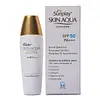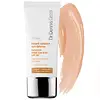What's inside
What's inside
 Key Ingredients
Key Ingredients

 Benefits
Benefits

 Concerns
Concerns

 Ingredients Side-by-side
Ingredients Side-by-side

Water
Skin ConditioningCyclopentasiloxane
EmollientEthylhexyl Methoxycinnamate
UV AbsorberZinc Oxide
Cosmetic ColorantButylene Glycol
HumectantGlycerin
HumectantIsononyl Isononanoate
EmollientPEG-9 Polydimethylsiloxyethyl Dimethicone
EmulsifyingAscorbyl Glucoside
AntioxidantSilica
AbrasivePolymethylsilsesquioxane
Disodium Phosphate
BufferingEthylhexyl Dimethoxybenzylidene Dioxoimidazolidine Propionate
UV AbsorberLauroyl Lysine
Skin ConditioningTitanium Dioxide
Cosmetic ColorantAcrylates/Dimethicone Copolymer
Skin ConditioningMethyl/Phenyl Polysilsesquioxane
Sodium Hydroxide
BufferingMethylparaben
PreservativeDisodium EDTA
Propylparaben
PreservativeStearyl Glycyrrhetinate
Skin ConditioningPotassium Hydroxide
BufferingArginine
MaskingHyaluronic Acid
HumectantTocopheryl Acetate
AntioxidantHydrolyzed Collagen
EmollientWater, Cyclopentasiloxane, Ethylhexyl Methoxycinnamate, Zinc Oxide, Butylene Glycol, Glycerin, Isononyl Isononanoate, PEG-9 Polydimethylsiloxyethyl Dimethicone, Ascorbyl Glucoside, Silica, Polymethylsilsesquioxane, Disodium Phosphate, Ethylhexyl Dimethoxybenzylidene Dioxoimidazolidine Propionate, Lauroyl Lysine, Titanium Dioxide, Acrylates/Dimethicone Copolymer, Methyl/Phenyl Polysilsesquioxane, Sodium Hydroxide, Methylparaben, Disodium EDTA, Propylparaben, Stearyl Glycyrrhetinate, Potassium Hydroxide, Arginine, Hyaluronic Acid, Tocopheryl Acetate, Hydrolyzed Collagen
Titanium Dioxide
Cosmetic ColorantZinc Oxide
Cosmetic ColorantWater
Skin ConditioningGlycerin
HumectantButylene Glycol
HumectantIsononyl Isononanoate
EmollientPentylene Glycol
Skin ConditioningCarthamus Tinctorius Seed Oil
MaskingOlea Europaea Fruit Oil
MaskingC12-15 Alkyl Benzoate
AntimicrobialCoconut Alkanes
EmollientHydroxyethyl Acrylate/Sodium Acryloyldimethyl Taurate Copolymer
Emulsion StabilisingAscorbyl Glucoside
AntioxidantMelatonin
AntioxidantTetrahexyldecyl Ascorbate
AntioxidantTocopherol
AntioxidantTocopheryl Acetate
AntioxidantNordihydroguaiaretic Acid
AntioxidantSodium Hyaluronate
HumectantPalmitoyl Tripeptide-38
Skin ConditioningEchium Plantagineum Seed Oil
Skin ConditioningOenothera Biennis Oil
EmollientBoerhavia Diffusa Root Extract
Skin ProtectingPhospholipids
Skin ConditioningSphingolipids
EmollientSaccharide Isomerate
HumectantCitrus Aurantium Dulcis Flower Extract
Skin ConditioningGlycolic Acid
BufferingSodium PCA
HumectantOleanolic Acid
Skin ConditioningPEG-60 Almond Glycerides
EmulsifyingHydrogenated Lecithin
EmulsifyingAcrylates/Carbamate Copolymer
Skin ConditioningBis-Ethylhexyl Hydroxydimethoxy Benzylmalonate
AntioxidantCoco-Caprylate/Caprate
EmollientAluminum Hydroxide
EmollientXanthan Gum
EmulsifyingCitric Acid
BufferingDisodium EDTA
Hydroxypropyl Cyclodextrin
MaskingSodium Citrate
BufferingCaprylyl Glycol
EmollientIsohexadecane
EmollientPolyhydroxystearic Acid
EmulsifyingSodium Hydroxide
BufferingTromethamine
BufferingBHT
AntioxidantPolysorbate 60
EmulsifyingCarbomer
Emulsion StabilisingIsopropyl Titanium Triisostearate
EmollientSorbitan Isostearate
EmulsifyingStearic Acid
CleansingBenzyl Alcohol
PerfumingPhenoxyethanol
PreservativePotassium Sorbate
PreservativeSodium Benzoate
MaskingCitrus Aurantium Dulcis Oil
MaskingMica
Cosmetic ColorantIron Oxides
Titanium Dioxide, Zinc Oxide, Water, Glycerin, Butylene Glycol, Isononyl Isononanoate, Pentylene Glycol, Carthamus Tinctorius Seed Oil, Olea Europaea Fruit Oil, C12-15 Alkyl Benzoate, Coconut Alkanes, Hydroxyethyl Acrylate/Sodium Acryloyldimethyl Taurate Copolymer, Ascorbyl Glucoside, Melatonin, Tetrahexyldecyl Ascorbate, Tocopherol, Tocopheryl Acetate, Nordihydroguaiaretic Acid, Sodium Hyaluronate, Palmitoyl Tripeptide-38, Echium Plantagineum Seed Oil, Oenothera Biennis Oil, Boerhavia Diffusa Root Extract, Phospholipids, Sphingolipids, Saccharide Isomerate, Citrus Aurantium Dulcis Flower Extract, Glycolic Acid, Sodium PCA, Oleanolic Acid, PEG-60 Almond Glycerides, Hydrogenated Lecithin, Acrylates/Carbamate Copolymer, Bis-Ethylhexyl Hydroxydimethoxy Benzylmalonate, Coco-Caprylate/Caprate, Aluminum Hydroxide, Xanthan Gum, Citric Acid, Disodium EDTA, Hydroxypropyl Cyclodextrin, Sodium Citrate, Caprylyl Glycol, Isohexadecane, Polyhydroxystearic Acid, Sodium Hydroxide, Tromethamine, BHT, Polysorbate 60, Carbomer, Isopropyl Titanium Triisostearate, Sorbitan Isostearate, Stearic Acid, Benzyl Alcohol, Phenoxyethanol, Potassium Sorbate, Sodium Benzoate, Citrus Aurantium Dulcis Oil, Mica, Iron Oxides
Ingredients Explained
These ingredients are found in both products.
Ingredients higher up in an ingredient list are typically present in a larger amount.
Ascorbyl Glucoside is a stable form of Vitamin C. It is created by combining glucose from starch.
When applied to skin, Ascorbyl Glucoside turns into Ascorbic Acid.
Ascorbyl Glucoside is an antioxidant. Antioxidants help fight free-radicals, or molecules that may damage skin cells.
It can help to reduce redness, improve skin texture, reduce the effects of aging, reduce the visibility of dark spots, and brighten skin.
Read more about other types of Vitamin C:
Learn more about Ascorbyl GlucosideButylene Glycol (or BG) is used within cosmetic products for a few different reasons:
Overall, Butylene Glycol is a safe and well-rounded ingredient that works well with other ingredients.
Though this ingredient works well with most skin types, some people with sensitive skin may experience a reaction such as allergic rashes, closed comedones, or itchiness.
Learn more about Butylene GlycolDisodium EDTA plays a role in making products more stable by aiding other preservatives.
It is a chelating agent, meaning it neutralizes metal ions that may be found in a product.
Disodium EDTA is a salt of edetic acid and is found to be safe in cosmetic ingredients.
Learn more about Disodium EDTAGlycerin is already naturally found in your skin. It helps moisturize and protect your skin.
A study from 2016 found glycerin to be more effective as a humectant than AHAs and hyaluronic acid.
As a humectant, it helps the skin stay hydrated by pulling moisture to your skin. The low molecular weight of glycerin allows it to pull moisture into the deeper layers of your skin.
Hydrated skin improves your skin barrier; Your skin barrier helps protect against irritants and bacteria.
Glycerin has also been found to have antimicrobial and antiviral properties. Due to these properties, glycerin is often used in wound and burn treatments.
In cosmetics, glycerin is usually derived from plants such as soybean or palm. However, it can also be sourced from animals, such as tallow or animal fat.
This ingredient is organic, colorless, odorless, and non-toxic.
Glycerin is the name for this ingredient in American English. British English uses Glycerol/Glycerine.
Learn more about GlycerinIsononyl Isononanoate is a synthetic skin-conditioner and texture enhancer. It is created from nonanoic acid, a fatty acid found in cocoa and lavender oil.
As an emollient, Isononyl Isononanoate helps keep your skin soft and smooth. This is because emollients create a barrier on the skin to trap moisture in.
Isononyl Isononanoate helps give products a velvet feel and improves spreadability.
Learn more about Isononyl IsononanoateSodium Hydroxide is also known as lye or caustic soda. It is used to adjust the pH of products; many ingredients require a specific pH to be effective.
In small amounts, sodium hydroxide is considered safe to use. However, large amounts may cause chemical burns due to its high alkaline.
Your skin has a natural pH and acid mantle. This acid mantle helps prevent harmful bacteria from breaking through. The acid mantle also helps keep your skin hydrated.
"Alkaline" refers to a high pH level. A low pH level would be considered acidic.
Learn more about Sodium HydroxideTitanium dioxide is a mineral UV filter widely used in sunscreens and cosmetics.
It is one of only two UV filters officially classified as “mineral” by regulatory agencies, the other being zinc oxide.
Titanium dioxide provides broad-spectrum protection mostly in the UVB and UVAII range, with some protection in the UVAI range.
While its UVA protection isn’t as strong as zinc oxide’s, the difference is minor.
A common myth is that mineral UV filters reflect UV light. However, modern research shows titanium dioxide absorbs UV radiation like chemical filters (~95% absorption & 5% reflection).
Thanks to its non-irritating nature, titanium dioxide is suitable for sensitive, acne-prone, or redness-prone skin. It is unlikely to cause "eye sting" like other sunscreen ingredients.
A major drawback of this ingredient is its white cast and thick texture. This is why mineral sunscreens often leave a white cast and are less cosmetically elegant than chemical/hybrid sunscreens.
To improve white cast and spreadability, micronized or nano-sized titanium dioxide is often used.
There are ongoing concerns surrounding nano-titanium oxide's impact on marine ecosystems.
There is no conclusive evidence that any form of titanium oxide (or any other sunscreen ingredients) will cause harm to marine ecosystems or coral reefs. The science is still developing but many consumers are keeping a close eye on this issue.
Please note, many destinations have reef-safety sunscreen rules. For instance, the U.S. Virgin Islands advises all visitors to use non-nano mineral sunscreens.
Nano mineral sunscreens once raised safety concerns about absorption into skin.
Extensive research has shown that they do not penetrate healthy or damaged skin; they remain safely on the surface and the top layer of dead skin (stratum corneum).
You'll likely find titanium dioxide bundled with alumina, silica, or dimethicone. These ingredients help make titanium dioxide highly photostable; this prevents it from interacting with other formula components under UV light.
Learn more about Titanium DioxideTocopheryl Acetate is AKA Vitamin E. It is an antioxidant and protects your skin from free radicals. Free radicals damage the skin by breaking down collagen.
One study found using Tocopheryl Acetate with Vitamin C decreased the number of sunburned cells.
Tocopheryl Acetate is commonly found in both skincare and dietary supplements.
Learn more about Tocopheryl AcetateWater. It's the most common cosmetic ingredient of all. You'll usually see it at the top of ingredient lists, meaning that it makes up the largest part of the product.
So why is it so popular? Water most often acts as a solvent - this means that it helps dissolve other ingredients into the formulation.
You'll also recognize water as that liquid we all need to stay alive. If you see this, drink a glass of water. Stay hydrated!
Learn more about WaterZinc Oxide is a mineral broad-spectrum UV filter; it is the broadest UVA and UVB reflector approved by the FDA. It also has skin protectant and skin soothing properties.
Zinc oxide is one of the most effective broad-spectrum UV filters. It protects against UVB, UVAII, and UVAI. In comparison to its counterpart titanium dioxide, zinc oxide provides uniform and extended UVA protection.
Another great benefit? This ingredient is highly photostable so it won't degrade easily under sunlight.
A common myth is that mineral UV filters are widely believed to primarily reflect UV light.
However, modern research shows titanium dioxide absorbs UV radiation like chemical filters (~95% absorption & 5% reflection).
Zinc oxide has great skin soothing properties so you'll likely find this in sunscreens formulated for sensitive skin or babies/children. It is unlikely to cause "eye sting" like other sunscreen ingredients.
Regulatory agencies consider zinc oxide to be non-toxic and safe. It has also been shown to not penetrate the skin.
Unfortunately, this ingredient does leave a visible white cast. This is why mineral sunscreens are often less cosmetically elegant than chemical or hybrid ones.
In cosmetics, zinc oxide can be found in both non-nano and nano-sized forms. The nano version is used to reduce white cast and improve the texture of sunscreen formulas.
There are ongoing concerns surrounding nano-zinc oxide's impact on marine ecosystems and whether it can be absorbed into skin.
Regarding marine ecosystems and coral reefs, there is no conclusive evidence that any form of zinc oxide (or any other sunscreen ingredients) will cause harm. The science is still developing but many consumers are keeping a close eye on this issue.
Please note, many destinations have reef-safety sunscreen rules. For instance, the U.S. Virgin Islands advises all visitors to use non-nano mineral sunscreens.
There has also been some stir about whether micronized or nano zinc oxide has potential photoxicity and absorption through the skin/lungs.
An in-vitro (done in a test tube or petri dish) study demonstrated micronized zinc oxide to have potential phototoxicity. There's no need to fret; the EU Commission's Scientific Committee on Consumer Safety has stated, "The relevance of these findings needs to be clarified by appropriate investigations in vivo." Or in other words, further studies done on living organisms are needed to prove this.
Current research shows zinc oxide nanoparticles do not penetrate intact or sunburned skin. They either remain on the surface or in the outermost layer of dead skin (stratum corneum).
Zinc oxide is one of only two classified mineral UV filters with titanium dioxide being the other one.
Fun fact: Zinc has been used throughout history as an ingredient in paint and medicine. An Indian text from 500BC is believed to list zinc oxide as a salve for open wound. The Ancient Greek physician Dioscorides has also mentioned the use of zinc as an ointment in 1AD.
Learn more about Zinc Oxide